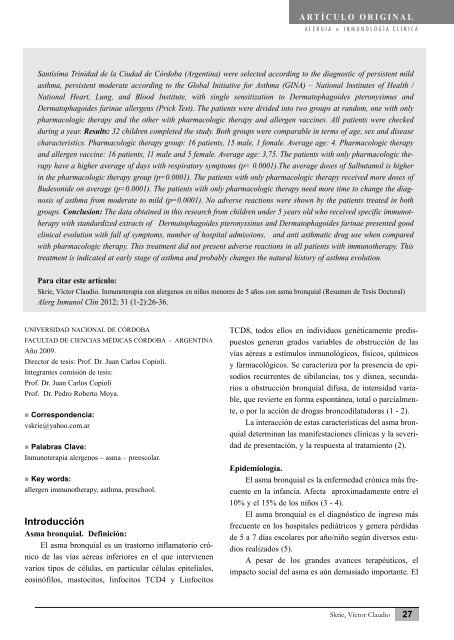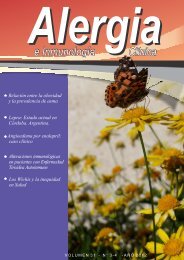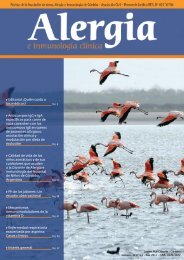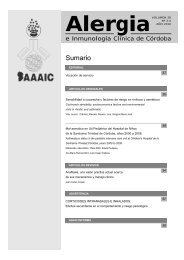VOLUMEN 31 Nº 1-2 año 2012 - cordobalergia.com
VOLUMEN 31 Nº 1-2 año 2012 - cordobalergia.com
VOLUMEN 31 Nº 1-2 año 2012 - cordobalergia.com
Create successful ePaper yourself
Turn your PDF publications into a flip-book with our unique Google optimized e-Paper software.
A R T Í C U L O O R I G I N A L<br />
A L E R G I A e I N M U N O L O G Í A C L Í N I C A<br />
Santísima Trinidad de la Ciudad de Córdoba (Argentina) were selected according to the diagnostic of persistent mild<br />
asthma, persistent moderate according to the Global Initiative for Asthma (GINA) – National Institutes of Health /<br />
National Heart, Lung, and Blood Institute, with single sensitization to Dermatophagoides pteronysimus and<br />
Dermatophagoides farinae allergens (Prick Test). The patients were divided into two groups at random, one with only<br />
pharmacologic therapy and the other with pharmacologic therapy and allergen vaccines. All patients were checked<br />
during a year. Results: 32 children <strong>com</strong>pleted the study. Both groups were <strong>com</strong>parable in terms of age, sex and disease<br />
characteristics. Pharmacologic therapy group: 16 patients, 15 male, 1 female. Average age: 4. Pharmacologic therapy<br />
and allergen vaccine: 16 patients, 11 male and 5 female. Average age: 3,75. The patients with only pharmacologic therapy<br />
have a higher average of days with respiratory symptoms (p= 0.0001).The average doses of Salbutamol is higher<br />
in the pharmacologic therapy group (p=0.0001). The patients with only pharmacologic therapy received more doses of<br />
Budesonide on average (p=0.0001). The patients with only pharmacologic therapy need more time to change the diagnosis<br />
of asthma from moderate to mild (p=0.0001). No adverse reactions were shown by the patients treated in both<br />
groups. Conclusion: The data obtained in this research from children under 5 years old who received specific immunotherapy<br />
with standardized extracts of Dermatophagoides pteronyssinus and Dermatophagoides farinae presented good<br />
clinical evolution with fall of symptoms, number of hospital admissions, and anti asthmatic drug use when <strong>com</strong>pared<br />
with pharmacologic therapy. This treatment did not present adverse reactions in all patients with immunotherapy. This<br />
treatment is indicated at early stage of asthma and probably changes the natural history of asthma evolution.<br />
Para citar este artículo:<br />
Skrie, Víctor Claudio. Inmunoterapia con alergenos en niños menores de 5 años con asma bronquial (Resumen de Tesis Doctoral)<br />
Alerg Inmunol Clin <strong>2012</strong>; <strong>31</strong> (1-2):26-36.<br />
UNIVERSIDAD NACIONAL DE CÓRDOBA<br />
FACULTAD DE CIENCIAS MÉDICAS CÓRDOBA - ARGENTINA<br />
Año 2009.<br />
Director de tesis: Prof. Dr. Juan Carlos Copioli.<br />
Integrantes <strong>com</strong>isión de tesis:<br />
Prof. Dr. Juan Carlos Copioli<br />
Prof. Dr. Pedro Roberto Moya.<br />
Correspondencia:<br />
vskrie@yahoo.<strong>com</strong>.ar<br />
Palabras Clave:<br />
Inmunoterapia alergenos – asma – preescolar.<br />
Key words:<br />
allergen immunotherapy, asthma, preschool.<br />
Introducción<br />
Asma bronquial. Definición:<br />
El asma bronquial es un trastorno inflamatorio crónico<br />
de las vías aéreas inferiores en el que intervienen<br />
varios tipos de células, en particular células epiteliales,<br />
eosinófilos, mastocitos, linfocitos TCD4 y Linfocitos<br />
TCD8, todos ellos en individuos genéticamente predispuestos<br />
generan grados variables de obstrucción de las<br />
vías aéreas a estímulos inmunológicos, físicos, químicos<br />
y farmacológicos. Se caracteriza por la presencia de episodios<br />
recurrentes de sibilancias, tos y disnea, secundarios<br />
a obstrucción bronquial difusa, de intensidad variable,<br />
que revierte en forma espontánea, total o parcialmente,<br />
o por la acción de drogas broncodilatadoras (1 - 2).<br />
La interacción de estas características del asma bronquial<br />
determinan las manifestaciones clínicas y la severidad<br />
de presentación, y la respuesta al tratamiento (2).<br />
Epidemiología.<br />
El asma bronquial es la enfermedad crónica más frecuente<br />
en la infancia. Afecta aproximadamente entre el<br />
10% y el 15% de los niños (3 - 4).<br />
El asma bronquial es el diagnóstico de ingreso más<br />
frecuente en los hospitales pediátricos y genera pérdidas<br />
de 5 a 7 días escolares por año/niño según diversos estudios<br />
realizados (5).<br />
A pesar de los grandes avances terapéuticos, el<br />
impacto social del asma es aún demasiado importante. El<br />
Skrie, Víctor Claudio<br />
27






